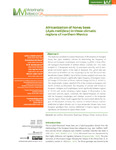
Please use this identifier to cite or link to this item:
http://ricaxcan.uaz.edu.mx/jspui/handle/20.500.11845/915Full metadata record
| DC Field | Value | Language |
|---|---|---|
| dc.contributor | 111167 | es_ES |
| dc.coverage.spatial | Zacatecas, México | es_ES |
| dc.creator | Medina Flores, Carlos Aurelio | - |
| dc.creator | Guzmán Novoa, Ernesto | - |
| dc.creator | Hamiduzzaman, Mollah | - |
| dc.creator | Aguilera Soto, Jairo Iván | - |
| dc.creator | López Carlos, Marco Antonio | - |
| dc.date.accessioned | 2019-04-01T19:45:01Z | - |
| dc.date.available | 2019-04-01T19:45:01Z | - |
| dc.date.issued | 2015-12 | - |
| dc.identifier | info:eu-repo/semantics/publishedVersion | es_ES |
| dc.identifier.issn | 2448-6760 | es_ES |
| dc.identifier.uri | http://localhost/xmlui/handle/20.500.11845/915 | - |
| dc.description.abstract | This study was conducted to analyze the process of Africanization of managed honey bee (Apis mellifera) colonies by determining the frequency of African and European morphotypes and mitotypes (mtDNA) in three different ecological environments of northern Mexico. Colonies (n= 151) were sampled in 1) temperate semi-dry; 2) semi-warm semi-dry; and 3) temperate sub-humid regions in the state of Zacatecas. The mtDNA type was determined by PCR-RFLP and the morphotype by the Fast Africanized Bee Identification System (FABIS). Out of all the colonies sampled in all areas, the mtDNA analysis showed a significantly higher frequency of European maternal lineage (77.5%) than of African maternal lineage (22.5%; P <0.0001). The morphometric analysis classified 47% of the colonies as European and 42.4% of them as Africanized. The frequency of colonies with African or European mitotypes and morphotypes varied significantly between regions (P <0.05) with results indicating a higher degree of Africanization in the semi-warm semi-dry region. Conversely, the highest frequency of colonies with the European morphotype and mitotype occurred in the temperate semi-dry region. These results suggest that the environment affects the degree of Africanization of honey bee colonies in northern Mexico. Colonies established at higher altitudes and in more temperate climates have more European genotypes than colonies established in tropical regions. Several hypotheses are discussed to explain these results. | es_ES |
| dc.language.iso | eng | es_ES |
| dc.publisher | Universidad Nacional Autónoma de México | es_ES |
| dc.relation | http://www.revistas.unam.mx/index.php/Veterinaria-Mexico | es_ES |
| dc.relation.uri | generalPublic | es_ES |
| dc.rights | Atribución-NoComercial-CompartirIgual 3.0 Estados Unidos de América | * |
| dc.rights.uri | http://creativecommons.org/licenses/by-nc-sa/3.0/us/ | * |
| dc.source | Veterinaria México OA Vol. 2, No. 4, pp. | es_ES |
| dc.subject.classification | CIENCIAS AGROPECUARIAS Y BIOTECNOLOGIA [6] | es_ES |
| dc.subject.other | Apis mellifera | es_ES |
| dc.subject.other | Africanization | es_ES |
| dc.subject.other | Morphotype | es_ES |
| dc.subject.other | Mitotype | es_ES |
| dc.subject.other | Climate | es_ES |
| dc.subject.other | Zacatecas | es_ES |
| dc.subject.other | México | es_ES |
| dc.title | Africanization of honey bees (Apis mellifera) in three climatic regions of northern Mexico | es_ES |
| dc.type | info:eu-repo/semantics/article | es_ES |
| Appears in Collections: | *Documentos Académicos*-- UA Veterinaría | |
Files in This Item:
| File | Description | Size | Format | |
|---|---|---|---|---|
| Medina-Flore et al-2015 Vet Mex.pdf | 495,75 kB | Adobe PDF |  View/Open |
This item is licensed under a Creative Commons License
